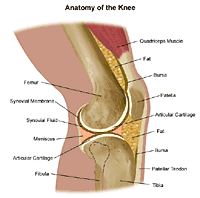Knee Replacement Surgery
 When a knee is so severely damaged by disease or injury, an artificial knee replacement may be considered. During this surgery, joint surfaces are substituted or replaced by prostheses. Nearly 600,000 knee replacement surgeries are done each year in the U.S., most commonly for people between the ages of 50 and 80 years old.
When a knee is so severely damaged by disease or injury, an artificial knee replacement may be considered. During this surgery, joint surfaces are substituted or replaced by prostheses. Nearly 600,000 knee replacement surgeries are done each year in the U.S., most commonly for people between the ages of 50 and 80 years old.
Who Might be a Candidate for a Knee Replacement?
The most common condition that results in the need for knee replacement surgery is osteoarthritis. This is a degenerative, joint disease that affects mostly middle-aged and older adults. Osteoarthritis is characterized by the breakdown of joint cartilage and adjacent bone in the knees. Other forms of arthritis, such as rheumatoid arthritis and arthritis that results from a knee injury can also lead to degeneration of the knee joint. In addition, fractures, torn cartilage, or torn ligaments also can lead to irreversible damage to the knee joint over the years.
The decision to replace the painful knee with an artificial one is a joint decision between you and your doctor. Other alternative treatments may first be used, including assistive walking devices, anti-inflammatory medicines, injections, and bracing.
UR Medicine's Orthopaedics and Rehabilitation can help. At the Evarts Joint Center at Highland Hospital, our team of knee replacement surgeons use the most advanced diagnostic tools to determine if surgery will put an end to your pain, and how extensive a procedure you need to reach this goal. We offer the most comprehensive orthopaedic services in the Rochester, NY Region.
Full Knee Replacement Surgery
Full knee replacement is the right option for people with severe osteoarthritis in the knee joint. The surgeon removes the damaged bone and cartilage and replaces it with prosthetic parts.
If your knee is severely damaged by arthritis or injury, it may be hard for you to perform simple activities, such as walking or climbing stairs. You may even begin to feel pain while you are sitting or lying down.
If nonsurgical treatments like medications and using walking supports are no longer helpful, you may want to consider total knee replacement surgery. Joint replacement surgery is a safe and effective procedure to relieve pain, correct leg deformity, and help you resume normal activities. Knee replacements were first performed in 1968. Since then, improvements in surgical materials and techniques have greatly increased its effectiveness. Total knee replacements are one of the most successful procedures in all of medicine. Recovery time for a full replacement will be longer than for the partial knee option.
Partial Knee Replacement Surgery
Partial knee replacement may be appropriate for young patients, or for people with limited damage from arthritis.
During knee replacement surgery, damaged bone and cartilage is resurfaced with metal and plastic components. In unicompartmental knee replacement (also called "partial" replacement) only a portion of the knee is resurfaced. This procedure is an alternative to total replacement for patients whose disease is limited to just one area of the knee.
Because a partial knee replacement is done through a smaller incision, patients usually spend less time in the hospital and return to normal activities sooner than total knee replacement patients.
There are a range of treatments for knee osteoarthritis, and your doctor will discuss with you the options that will best relieve your individual osteoarthritis symptoms.
Choosing a Full or Partial Replacement
See our Comparing Knee Replacement Surgery Options page for a detailed comparison of the two surgery options.